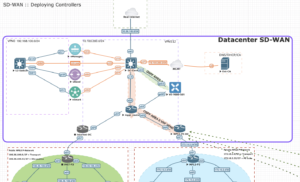In Campus designs, where VLAN distribution is needed to provide enough IP space to the access-layer, bulk editing VLAN assignments to access-ports can be a troublesome job.
Let’s say you have one functional VLAN called “Guest”. The distribution-switch act as the gateway for 50 access-switches and their VLAN’s. You will need to install 50 VLAN-id’s on the distribution-layer for the function of “Guest” to divide the connected the IP space.
On the access-layer you need to assign ports to this functional VLAN, resulting in manual port configuration with different VLAN variables over all switches. Excel can help, even python scripting can relief some of this burden. But it needs to be developed.
Since Cisco IOS 15.2(3)E3 Cisco has introduced VLAN assignment via VLAN name instead of VLAN-id.
The syntax under the Interface level:
switchport access vlan name {name-of-vlan}Let’s give it a try!
ACCESS#sh vlan brief
VLAN Name Status Ports
---- -------------------------------- --------- -------------------------------
1 default active Gi0/1, Gi0/2, Gi1/0, Gi1/1
Gi1/2, Gi1/3
100 userlan active Gi0/3
200 OFFICE active
300 TO_DC active
400 PUBLIC active
1002 fddi-default act/unsup
1003 token-ring-default act/unsup
1004 fddinet-default act/unsup
1005 trnet-default act/unsup
3000 QUARANTINE active
ACCESS#
ACCESS#conf t
Enter configuration commands, one per line. End with CNTL/Z.
ACCESS(config)#vlan 2000
ACCESS(config-vlan)#name GUEST
ACCESS(config-vlan)#exit
ACCESS(config)#
ACCESS(config)#
ACCESS(config)#
ACCESS(config)#exit
ACCESS#
*Jan 9 21:21:16 CET: %SYS-5-CONFIG_I: Configured from console by console
ACCESS#sh vlan brief
VLAN Name Status Ports
---- -------------------------------- --------- -------------------------------
1 default active Gi0/1, Gi0/2, Gi1/0, Gi1/1
Gi1/2, Gi1/3
100 userlan active Gi0/3
200 OFFICE active
300 TO_DC active
400 PUBLIC active
1002 fddi-default act/unsup
1003 token-ring-default act/unsup
1004 fddinet-default act/unsup
1005 trnet-default act/unsup
2000 GUEST active
3000 QUARANTINE active
ACCESS#
ACCESS#
ACCESS#sh ip int brief
Interface IP-Address OK? Method Status Protocol
GigabitEthernet0/0 unassigned YES unset up up
GigabitEthernet0/1 unassigned YES unset down down
GigabitEthernet0/2 unassigned YES unset down down
GigabitEthernet0/3 unassigned YES unset up up
GigabitEthernet1/0 unassigned YES unset down down
GigabitEthernet1/1 unassigned YES unset down down
GigabitEthernet1/2 unassigned YES unset down down
GigabitEthernet1/3 unassigned YES unset down down
Vlan100 172.16.100.250 YES NVRAM up up
ACCESS#
ACCESS#
ACCESS#sh int trunk
Port Mode Encapsulation Status Native vlan
Gi0/0 on 802.1q trunking 100
Port Vlans allowed on trunk
Gi0/0 100,200,400,3000
Port Vlans allowed and active in management domain
Gi0/0 100,200,400,3000
Port Vlans in spanning tree forwarding state and not pruned
Gi0/0 100,200,400,3000
ACCESS#conf t
Enter configuration commands, one per line. End with CNTL/Z.
ACCESS(config)#int range gigabitEthernet 1/0 - 3
ACCESS(config-if-range)#switchport access ?
vlan Set VLAN when interface is in access mode
ACCESS(config-if-range)#switchport access vlan ?
<1-4094> VLAN ID of the VLAN when this port is in access mode
name Set VLAN when interface is in access mode
ACCESS(config-if-range)#switchport access vlan name GUEST ?
<cr>
ACCESS(config-if-range)#switchport access vlan name GUEST
ACCESS(config-if-range)#
ACCESS(config-if-range)#
ACCESS(config-if-range)#do sh run int g1/0
Building configuration...
Current configuration : 83 bytes
!
interface GigabitEthernet1/0
switchport access vlan 2000
negotiation auto
endNow you can perform this task just with one syntax on all switches. The name will make a match in the VLAN Database and will assign the associated VLAN-id to the port.
What about trunk links to end devices??
ACCESS(config)#int range gigabitEthernet 1/0 - 3
ACCESS(config-if-range)#switchport trunk encapsulation dot1q
ACCESS(config-if-range)#switchport mode trunk
ACCESS(config-if-range)#switchport trunk allowed vlan ?
WORD VLAN IDs of the allowed VLANs when this port is in trunking mode
add add VLANs to the current list
all all VLANs
except all VLANs except the following
none no VLANs
remove remove VLANs from the current list
ACCESS(config-if-range)#switchport trunk allowed vlan GUEST
Command rejected: Bad VLAN list - character #1 is a non-numeric
character ('G').
% Range command terminated because it failed on GigabitEthernet1/0Bad luck, but we can speed up the change for our access-ports. Nice feature. If I would give this points, it would be 42.


